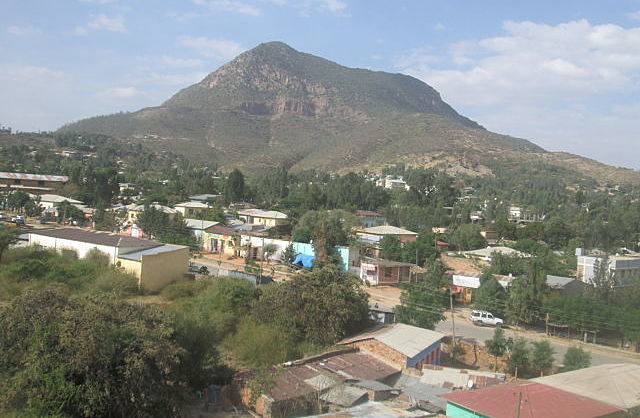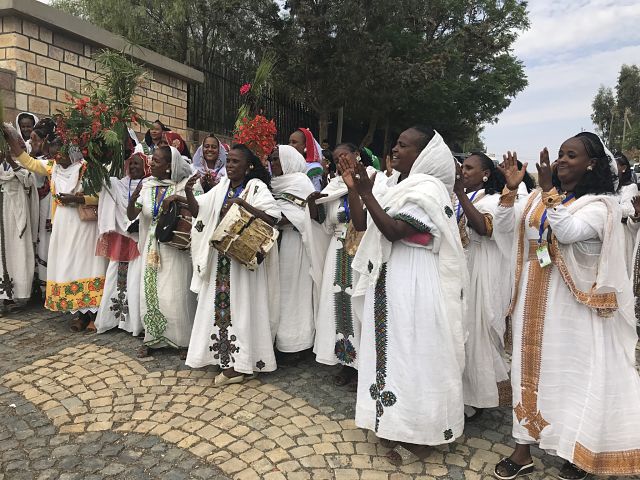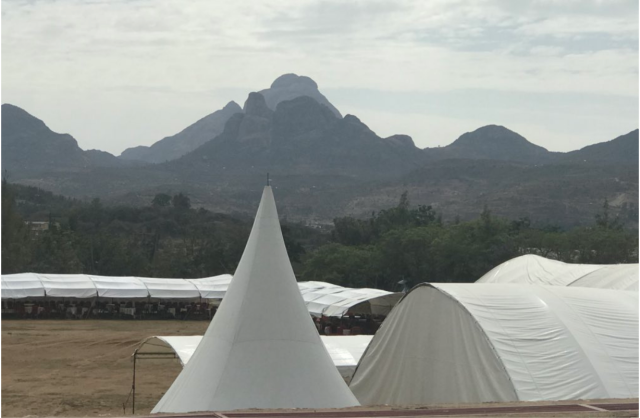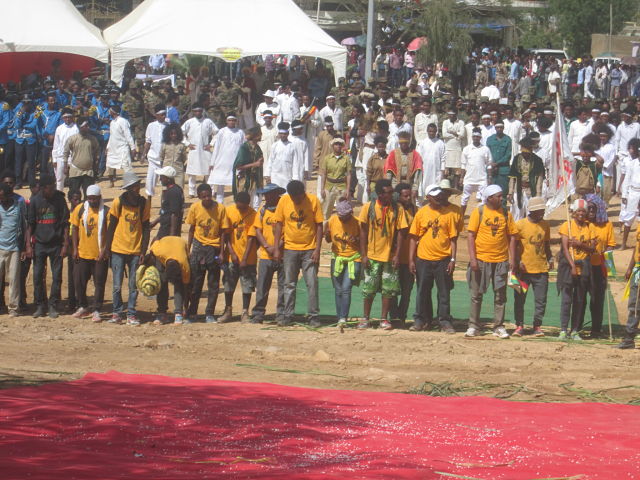 Below is a timely essay by Professor Ayele Bekerie dedicated to the 124th anniversary of Ethiopia's victory at the Battle of Adwa. It's published today in honor of Black History Month. (Image: The town of Adwa. Photo by Ayele Bekerie)
Below is a timely essay by Professor Ayele Bekerie dedicated to the 124th anniversary of Ethiopia's victory at the Battle of Adwa. It's published today in honor of Black History Month. (Image: The town of Adwa. Photo by Ayele Bekerie)
Tadias Magazine
By Ayele Bekerie, PhD
February 1st, 2020
The Making of Global Adwa: An Essay Dedicated to 124th Anniversary of Ethiopia’s Victory at the Battle of Adwa
Ethiopia (TADIAS) — At the beginning of March 1896, the Ethiopians, at the Battle of Adwa, startled the world. They decisively defeated the Italian/European army, an army trained and armed for a colonization mission. The victory not only put to a halt Italians’ colonial ambition in Ethiopia, but it also sent shockwaves throughout Europe. The victory undoubtedly marked the beginning of the end of colonialism in Africa. The victory also marks the beginning of the end of the notion of nativism and European white supremacy.
As The New York Times of March 3, 1896 puts it, ‘Italy’s Terrible Defeat’ was the most astonishing news, in the world. At the end of the 19th century, a history was made with the victory at the Battle of Adwa. It was perhaps by far the most discussed about and newsworthy event of the time. When the victory was announced to the world, the world in return began to pay attention to Adwa, or for that matter, to Ethiopia. The more the deed is channeled through the media in various languages in Africa, Europe and the Americas, the more people began to admiringly and amusedly, depending which side you were on, sought to connect to the event by learning more about or identifying with Adwa. Europeans, who were already became comfortable with their vast colonial territories and subjects, were shaken to the core. The colonial rule they instituted, be it direct or indirect, was bound to fall apart. Adwa emerged with multiple meanings and interpretations encompassing almost the whole world.
The victory, in particular, became a relevant news to those whose freedom was snatched and subjected to colonial/nativist rule. It directly and intimately appealed to them. It offered them a lesson that they wanted to put into practice by intensifying their struggles against colonial domination and subjectivity. News released from London, New York and Paris reached all the other cities and the continents of the world. Adwa, according to news reports, was arguably the most widespread breaking news story at that time. It was a story that instantly made the words, such as Adwa, Menelik, Taitu, Alula, Balcha and Mekonnen household terms. The purpose of this paper is to find ways to return Adwa to its global status by constructing major cultural and educational centers near the site of the battlefield. There is an urgent need to make Adwa memorable beyond the ritual annual celebration. It seeks worldwide support to make Adwa a dynamic global center of excellence for Pan-African solidarity and learning.
With the victory, Adwa became a term of global significance. It is a term that people, throughout the world, instantly recognize. They recognize Adwa because Adwa set to inspire the colonized to rise up against their colonial oppressors. Adwa charts the immense possibilities to resist European hegemony and falsely fabricated supremacy. Adwa is the proof for rejecting the notion of supremacy. Adwa has to shine and shine forever, for freedom is a sacred attribute that everybody deserves, black or white. What can be done to turn what has become the global-scale event to permanency? How can we transform Adwa so that it becomes a global heritage and cultural center?
As we are celebrating the 124th anniversary of the victory, we must think of re-turning Adwa as a dynamic site of global significance. In fact, we need to make Adwa an enduring global site and world heritage by establishing, for instance, a Pan-African institution of higher learning and cultural center in Adwa. Adwa, as pointed out before, ought to be registered as tangible cultural heritage or as tangible cultural landscape. Moreover, Adwa should not only be qualified to become a federal city, but it should also achieve a status of globality where the citizens of the world engage in research and education beneficial to all humanity. Imagine, a Pan-African center of excellence where Africa’s history and culture are studied, published and disseminated in the context of world history and culture. Adwa and what happened there in 1896 should set the stage for the world community to engage in research and education with focus and emphasis on equality and dignity of fellow humans.
We need to systematically study the event of March 1896 in Adwa, because the tendency to become inattentive to persistent Italian colonial ambition made Ethiopia pay a heavy price. The Italians tried to colonize the country for the second time in 1935. This time the Italians came prepared, actually overprepared, for they used banned chemical weapons to annihilate the Ethiopian army. Adwa did not repeat itself at Maichew, the battleground in which the Fascist Italian forces used weapons of mass destruction to kill thousands of poorly prepared and armed Ethiopian forces in 1935.
Despite the Italians invasion and occupation of Ethiopia from 1935 to 1941, our patriots never gave up and courageously resisted the occupation. Eventually, the Italians were pushed out of Ethiopia. The two events taught a lesson to Ethiopians to protect and defend their independence at all times.
In Adwa, the plan to construct a standalone and permanent cultural center and institution of higher learning is under review. Having divided the plan into phases, the Adwa Pan-African University’s (APAU) Coordinating Committee has convened local, regional and international conferences, rallied regional and federal governments, drafted the charter and concept paper, charted plan of action and selected a consortium of architects to design the University.
At the moment, phase 2 of the plan is proceeding. The architects are designing the University’s buildings and landscape. APAU commands a 135-hectare of hilly land at the north-east part of the City. The location has a spectacular view of the now famous and historic chains of Adwa mountains, such as Abune Gerima, Kidane Mehret, Gesseso, Semayata and Raeyo. Soloda mountain is an ever-present mountain with a dominant view from any part of the City. The hilltop of the University provides a great view of Soloda. It also presents a panoramic view of the City itself. Almost all the historic churches and monasteries as well as mosques not to mention the cityscapes provide a spectacular view from the hill.
It is a common knowledge that establishing a university has the capacity to transform a city. This has already been proven in places, like Mekelle, Bahrdar, and Hawassa. Mekelle almost literally changed from a modest city to an international and dynamic city with a population expanding into half a million. One of the main contributing factors for Mekelle’s development is the presence of Mekelle University.
Given the proximity of Adwa to Aksum, an ancient city, the two combined are capable of providing ample opportunities to further develop tourism, local and international. Aksum and Adwa, from the perspective of long Ethiopian history, should be developed jointly, thereby creating a platform to tell ancient and contemporary stories of the great land.

This is a picture taken in April 2018 in Adwa. The women are celebrating the decision to establish Adwa Pan African University in Adwa. (Photo by Ayele Bekerie)

The Site of an International Conference on the Establishment of Adwa Pan-African University. The historic mountains of Adwa served as a background. (Photo by Ayele Bekerie, April 2018)

Owning Adwa: The reenactment of the Battle of Adwa in Adwa by the Adwa Journey (YeAdwa Guzo) Team and members of the National Theatre, March 1, 2017. (Photo by Ayele Bekerie)
The Queen of Sheba, Menelik I and the Arc, St. Yared, the great chant composer, Ras Mekonnen Wolde Mikael, the Commander of the Victorious Ethiopian Army, Taitu Bitul, the co-leader and strategist, Fitawrari Gebeyehu, the brave and ferocious military leader, Liqe Meqwas Abate BwaYallew, the finest gunner, Dejach Balcha, army general and fearless fighter, Ras Alula, the finest military strategist and tactician, Ras Sebhat, the realist and the critical rejoinder of the Ethiopian cause, Teferi Hagos, the defector and the helper of the cause, and Awalom, the master spy and also the defender of the cause, are just few great names of the great ancient and contemporary land. These are names permanently inscribed, from heritage point of view, in the symbols and meanings of Ethiopia. They are indelible national landmarks.
Adwa, to further highlight its importance in Ethiopian history, was the final and an irreversible site of engagement. Italians were creeping along to expand their African colonial territory by first moving into Eritrea and later into Ethiopia by occupying places, such as Adigrat. They ventured up to Amba Alage where Major Tosseli’s battalion was crushed and he lost his life. Tosseli was dreaming to become the Italian Livingstone or Rhodes. A graduate of a military academy, he was one of the most ardent advocates of restoring the past Roman glory by extending Rome in north-east Africa. Tosseli preached empire and attempted to rally Italians to his passionate but wicked colonial mission. Fortunately, the Italians were not enthused. War in far away places and paying sacrifices to a colonial gamble was not attractive enough to them. Tosseli had to do the mission almost by himself, accompanied by 2000 Italians and ascaris or mercenaries.
Tosseli, the nativist or the theoretician and the military strategist par excellence, did not realize that the natives have gone far enough to constitute themselves as one people. They have already created and maintained a country that is striving to accommodate diversity. They have written treatises and voluminous works of religious living. And they had the state of mind to willingly resist and fight foreign enemies. If we have to state the facts, the Ethiopians embraced Christianity and welcomed the emergence of Islam long before Italy became a modern country. Tosseli’s theory of empire lacked several attributes. He failed to fully understand the people he wanted to diminish into colonial subjects.
Lt. Colonel Galliano, the other nativist, ordered the construction of a fortress 70 meters high, 16 feet deep at the ground level and 6 feet thick at the top in Mekelle. He built the fortress around the Endayesus Hill. He built bunkers and hidden windows to mount the guns and the artilleries. He also built three defensive perimeters using trenches, barbed wires, sharp pieces of woods and broken glasses. He also secured temporarily a source of water not far from the hill. And yet, he did not manage in this monster-like fortress to stay for few months and he was plucked out of it by gallant Ethiopian forces.
Ras Mekonnen, the commander of the Ethiopian army, fresh from a victory at Amba Alage, arrived in Mekelle and established a camp not far from the hill. The siege of the fortress was immediate. They asked Galliano to vacate the fortress and a series of negotiations were conducted to reverse the siege.
Galliano refused and the ensuing battle that lasted for about two weeks resulted in heavy casualities among Ethiopians. An estimated 500 Ethiopians lost their lives. It was then Empress Taitu who came up with the idea of blocking the water source of the Italians. She recruited about 500 soldiers to block the water. The blockade was very successful and Galliano was forced to surrender and vacate the fortress. The Ethiopians immediately dismantled the fort. The spring water source was renamed Mai Aneshte or woman’s water in honor of Empress Taitu Bitul.
Amba Alage was the place where Ethiopians showed for the first time that they would fight to keep the integrity and honor of the country, regardless of their ethnic background. For the first time, Shoans, Hararis and Tigrayans forces formed an organic alliance to confront the colonial Italian army and won.
Amba Alage, Mekelle, and Adwa taught us extremely valuable lessons in the context of national identity formation. In a complex multiethnic society, to think of self-determination as an end by itself is to invite an irreconcilable disaster. In all the three battlefields, the patriotic forces put to good use of what they have in common. They successfully pulled their forces and resources together to form and uphold air-tight unity which turned out to be a winner, a big winner.
The Tigrayans, the Shoans, the Hararis in Amba Alage and Mekelle and in Adwa, virtually all the ethnic groups affirmed their complex sense of identity and were able to execute a battle plan with irreversible and triumphal outcome. The patriots charted once and for all the critical significance of prioritizing country to ethnicity. The deeds of Adwa also solidified the Ethiopian sense of modernity. Issues can and ought to be resolved by upholding the cardinal value of unity. It was the united force of the country that defeated the Italian army. Our unity paves the way, even if we continue not to seize it, for just and democratic way of doing things. It is critical at this juncture to remind ethnonationalists that Adwa is not only a foundation of our contemporary state and nationhood, but it is also a global phenomenon serving as a symbol of freedom and independence, agency and personhood to all humankinds. In this spirit, APAU will be built and serve us all.
APAU is being established on the basis of Pan-African principles and practices. By systematically documenting, researching and narrating the stories of African people, we contribute to broaden the public square, the democratic space, global conversations and the equality of human beings. It is time for the citizens of the world to participate in the building of local and global Adwa. Placing African history on the stage of world history has paramount importance to peaceful human ventures in the 21st century.
Adwa then Adwa now provides an extremely useful lessons to the whole world. Adwa rhymes with freedom and independence. Adwa reinforces the dignity of all human beings. Adwa, therefore, needs to be remembered with permanent cultural center and an institution of higher learning. The project that started to globalize Adwa, some four years ago, has gone through phases and, at the moment, a consortium of architects is designing the buildings and the landscapes of APAU. Adwa is eternal.
—
About the author:
Ayele Bekerie is an Associate Professor and Coordinator of PhD Program in Heritage Studies and Coordinator of International Affairs at Mekelle University’s Institute of Paleo-Environment and Heritage Conservation. Previously, he was an Assistant Professor at the Africana Studies and Research Center at Cornell University in the United States. Ayele Bekerie is a contributing author in the acclaimed book, “One House: The Battle of Adwa 1896 -100 Years.” He is also the author of the award-winning book “Ethiopic, An African Writing System: Its History and Principles” — among many other published works.
Related:
The Concept Behind the Adwa Pan-African University: Interview with Dr. Ayele Bekerie
Ethiopia: The Victory of Adwa, An Exemplary Triumph to the Rest of Africa
Adwa: Genesis of Unscrambled Africa
119 Years Anniversary of Ethiopia’s Victory at the Battle of Adwa on March 1st, 1896
Reflection on 118th Anniversary of Ethiopia’s Victory at Adwa
The Significance of the 1896 Battle of Adwa
Call for the Registry of Adwa as UNESCO World Heritage Site
Join the conversation on Twitter and Facebook.

























